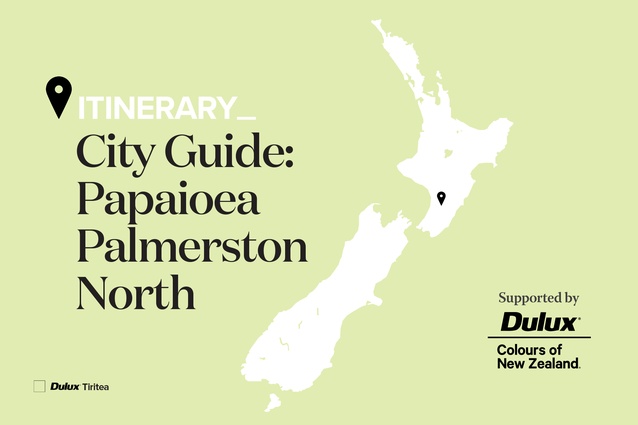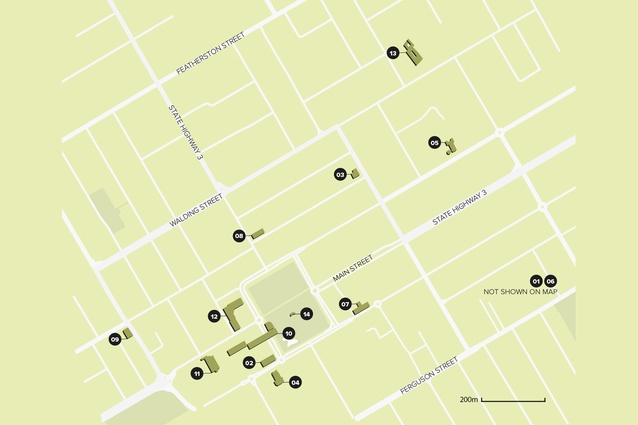Itinerary City Guide: Papaioea Palmerston North
In this month's Itinerary, supported by Dulux Colours of New Zealand, Andrew Barrie and Julia Gatley explore the architectural highlights of Papaioea Palmerston North, a city boasting a surprising roll-call of architectural offspring and spacious charm. Read on to learn about the architectural treasures the 'Rose City' has to offer and discover the history of one of New Zealand's most populous cities.
With a population of 80,000, Papaioea Palmerston North is one of the nation’s largest provincial cities. The smart alec would ask: “Why is it there?” It does not have the natural port or landing point which spurred the development of most other New Zealand cities. The trigger was much more modest – a clearing in the forest. Ngāti Rangitāne whakapapa to the area and, in the 1860s, the Crown acquired the clearing. Scandinavians were among the first Pākehā settlers and the milling of the surrounding forest became an early industry. The railway spurred growth when it arrived in 1886, the line running through the centre of The Square, giving the city a heart and life. The Square continues to define the city’s layout today but the railway line was relocated to the northern outskirts in 1963 and 1964. Extraction of the line left key streets uncannily wide and The Square suffered, despite attempts to reinvigorate it. The seven-hectare green space gives the CBD a sense of spaciousness but it is too big to be urban.
The population reached 20,000 in 1930 and Palmerston North was proclaimed a city. The construction of a public hospital, Massey University (from 1927) and Linton Military Camp (from 1942) all helped to ensure further growth. The Technical School that would become the Polytechnic started in 1909 and the Teachers’ Training College was established in 1956. By the 1990s, staff and students in the education sector accounted for over 40 per cent of the city’s population. Importantly, these institutions were established after the central city had coalesced and now largely occupy peripheral locations – Massey and the associated government research centre sit in farmland well out of town. So, unlike key institutions in other major New Zealand cities – think of the university Clocktower building in Dunedin or the former campus that is now Christchurch’s Arts Centre – those in Palmerston North contribute very little to the city’s urban character.
Palmerston North is like several other New Zealand cities, though, in having had an architect-mayor; Ludolph Georg West (1845–1919), later joined by his son Ernst, ran a firm that was important in the late 19th and early 20th centuries, with key extant projects including the Masonic Lodge at 393 Church Street (1908) and the Church of Christ, Scientist at 409 Church Street (1933). However, the large institutions drew architects from elsewhere, notably from Wellington, just a two-hour drive away, but also folk from Auckland, Christchurch and Hawke’s Bay. Perhaps because of this constant traffic, the city hasn’t fostered a John Scott or John Blair-like character to differentiate the local scene.
Surprising, then, is the city’s roll-call of architectural offspring, including, and surely not limited to, NZIA Gold Medal-winner Julie Stout, along with Richard Priest, Hugh Tennent and Columbia University’s Professor Mark Wigley, all of whom knew one another back in the day.
Just as a clearing was Palmerston North’s point of formation, space and spaciousness continue to be among its key charms. Since 2012, along with its work on revitalising The Square, the City Council has been investing in landscaping and walkways alongside the Manawatū River to improve its amenity value and encourage greater recreational use. Meanwhile, the institutions continue to grow. There’s design work to be done here. And there’s the room for it.
THE ITINERARY

01. 1903 – Caccia Birch House
130 Te Awe Awe Street
Ludolph Georg West
West, who later practised with his son, was a key figure in Palmerston North’s early architectural scene. West designed this house in several phases as it was taken over by owners of increasing means. The by-then 28-room residence was famously occupied by the Governor of New Zealand, Lord William Plunket, from 1908 to 1910, after he’d offered his official Wellington residence to MPs after a fire destroyed Parliament Buildings. A Heritage New Zealand Pouhere Taonga (HNZPT) Category 1 historic place, the building is now a Council-owned functions venue.

02. 1906 – Grand Hotel Building (former)
41–44 The Square and Church Street
Joseph Clarkson Maddison
The Grand was built to replace an earlier hotel lost to fire. J C Maddison, a well-known Christchurch architect, had designed a number of hotels there. This one is classical and its distinctive Mansard roof was derived from French Baroque and Second Empire architecture. Queen Elizabeth and Prince Philip stayed here during their 1953–1954 visit. More generally, its location was handy to the train station (see listing 14). The hotel closed in the 1970s and the building has since had various uses. HNZPT Category 1.

03. 1909 – Palmerston North Technical School (former)
135 King Street and Princess Street
Frederick de Jersey Clere
Living in Feilding, Whanganui and Wellington, Clere was prolific across the southern half of the North Island. This was Palmerston North’s first technical school but the building was later used by the Teachers’ College and, then, by the Polytechnic. It was savagely altered in the 1930s, likely in response to the Napier earthquake, with the gables being removed. These were reconstructed but the internal structure was removed as the building was absorbed into UCOL’s large Learning Commons complex by Designgroup Stapleton Elliott (1998). HNZPT Category 2.
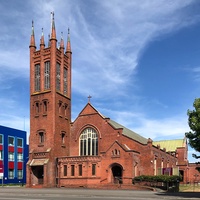
04. 1914 – All Saints Anglican Church
348 Church Street
Frederick de Jersey Clere
Clere is best known as an architect of churches; he designed more than 100, many in his role as architect to the Wellington Anglican Diocese. This building is unostentatious but, like many local churches, is confidently pressed against the street, becoming a key contributor to the city’s urban character. A Category 1 historic place, the building is currently closed as an earthquake risk. In 1910, an earlier Carpenter Gothic church was pushed to the rear of the site to operate as a hall but now, once again, serves as the church.
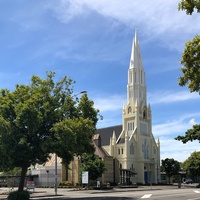
05. 1923–1925 – Cathedral of the Holy Spirit (Catholic)
197 Broadway Avenue
Clere & Clere
When modernism was rising to the fore in 1920s Europe, New Zealand was still building Gothic Revival churches. Like Clere’s more famous St Mary of the Angels, Wellington (1922), this one was built in reinforced concrete and then given the pointed arches and pinnacles of the Gothic, and a lofty spire. A timber roof structure provides contrast internally. It was renovated by Designgroup Elliott Associates in the 1980s and, since 2001, entry has been through an octagonal addition by Dickson Lonergan Architects. HNZPT Category 1.
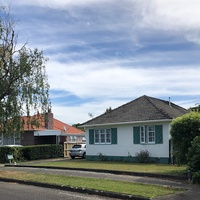
06. 1937–1945 – Savage Crescent State Housing Scheme
Savage Crescent
Department of Housing Construction under F Gordon Wilson
From 1937 to 1949, our first Labour government built 30,000 state rental housing units up and down the country, many of them detached houses laid out in garden suburb-type fashion. The Savage Crescent scheme is distinguished by its naming in honour of Prime Minister Michael Joseph Savage (1872–1940) and its oval street layout, ringing a large, open green space. It is now a leafy glade, with many of the houses sold off, and is zoned as a conservation area in the City Council’s district plan, meaning special rules apply when additions are proposed.
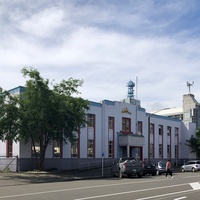
07. 1940 – Palmerston North Police Station (former)
351–361 Church Street
John Mair, Government Architect
During Mair’s term as Government Architect, he drew in modernising, if not quite modern, ways of thinking. The design finds a middle ground between subdued stripped classicism and Kiwi-fied art deco. As at his Rotorua Police Station, completed the same year, Mair set out a decorative scheme that – unusually, for the time – employs Māori motifs; where Rotorua employed elaborate carved forms, here, we see a simple kōwhaiwhai frieze. The building is now closed, with the constabulary located in a larger building down the block. HNZPT Category 2.

08. 1957 – NZI House (former)
38–42 Rangitikei Street
Gummer and Ford
Between the wars, Gummer and Ford was the nation’s most prominent firm, operating all over the country. Insurance companies were frequent clients and the practice completed a number of offices in provincial centres for NZI, including in Nelson (1956) and Tauranga (1958), all to a similar stripped classical design of which this remains the most intact. The projects marked the end of Gummer and Ford’s ‘moderate modernism’, as the two founders retired shortly thereafter, and leadership of the New Zealand scene passed to a new generation with more assertive approaches.

09. 1954–1964 – Māori Battalion Memorial Hall
138 Cuba Street
John Scott
Futuna Chapel (1958–1961) is John Scott’s best-known building, promoted by Russell Walden as whare-meets-woolshed and an expression of a bicultural architecture. Bill McKay countered that Futuna was assimilationist rather than bicultural, as its Māori elements are not overt. He found the Māori Battalion Memorial Hall to be a stronger expression of a bicultural architecture, because its whakairo and paepae are overtly expressed, with an appropriately awkward relationship with the building’s Western/brutalist,
off-form concrete.
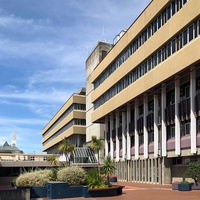
10. 1969–1979 – Civic Administration Building
32 The Square
Maurice Patience & Son
After the relocation of the railway line out of The Square, the City Council held a competition for the design of its new office building, which was to encompass a theatre, a conference centre and retail areas as well. It is a major building on the south-west side of The Square and, in a daring move, bridges the road and projects into the green space. Dominant horizontal bands of concrete and glass are relieved by the expression of vertical circulation. The base of the complex has been filled in with cafés and the like, and these address the open space of The Square.

11. 1977 – Te Manawa Te Papaioea
326 Main Street
David Taylor, Architect
In awarding this project a Local Enduring Architecture Award last year, the jury stated, “Heralded as a new direction for the art scene in the Manawatū, and indeed the rest of the country, the Manawatū Art Gallery embraced the latest modernist ideas, and used textured and cast-in-situ concrete, metal and timber in a new way. The existing building is stage one of a larger, unrealised development. Clerestory windows, skillion roofs and a central mezzanine floor provide a variety of exhibition spaces, viewing points and office accommodation.”

12. 1992–1996 – Palmerston North City Library
4–9 The Square
Athfield Architects
This project comprised the adaptive reuse of the city’s old DIC department store, which was made up of three old buildings, including the landmark four-storey portion built in 1927–1928. The intervention cut into one bay of the old façade and introduced a pedestrian street through to George Street, ramped to take library users up to a first-floor entry. This allowed ground-floor spaces to be rented out, generating income. The project earned an NZIA National Award in 1998, and the building retains the Category 2 listing it had prior to alteration.
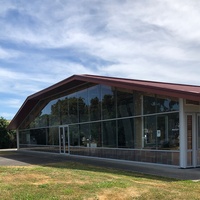
13. 2006 – Mana Tamariki
165 Grey Street
Tennent Brown Architects
This was one of the first projects to combine immersion te reo Māori schools at kindergarten, primary and secondary levels in a single complex. The street elevation and ātea out front hint at, but don’t imitate, marae forms. The open interior is organised around a couple of courtyards that bring light, air and greenery into the centre of the complex. Stormwater reticulation into swales and natural ventilation further embed the building into the whenua. This project was the winner of an NZIA National Award in 2010.

14. 2008 – Hopwood Clock Tower
The Square
CCM Architects
This project embodies the cycles of urban renewal. When the rail line sliced through the city, The Square was home to the central railway station. The 1950s’ Clock Tower accommodates a clock and chimes that were part of the city’s 1906 Post Office but were removed in 1942 after an earthquake. With the line’s relocation to the edge of town, the Clock Tower became The Square’s new focal point. CCM Architects reworked the tower with a lantern on top and a redesigned base as part of a wider redesign of The Square.
Worth the drive
Massey University Turitea Campus
University Avenue, Palmerston North
Early buildings include the Refectory (1930) and Main Building (1931) by American- born Roy Lippincott, best known as the architect of the ClockTower building at the University of Auckland (1921–1926). A burst of campus building in the 1960s was planned by the Ministry of Works, under Government Architect Fergus Sheppard. The site includes buildings by the Ministry of Works (1964, 1971, 1967–1974 and 1978) and Wylde, Brown & Roberts (1966), as well as the Student Union by Warren and Mahoney (1966–1967).
Old Dairy Factory (1929)
21 Dairy Farm Road, Palmerston North Roy Lippincott
Originally a model dairy factory shared between Massey and the then-newly established Dairy Research Institute, it was later taken over by the DSIR and is now an agritech business start-up hub with a great café.
Te Awahou (2017)
92 Main Street, Foxton Bossley Architects
This is a fascinating complex that both celebrates the area’s Māori and Dutch heritage, and supports contemporary community life.
Te Matapihi Bulls Community Centre (2020)
4 Criterion Street, Bulls Architecture Workshop
Another new-breed community centre that combines library, town hall, Plunket rooms, visitor information and public toilets.
SOURCES
The Heritage New Zealand Pouhere Taonga website is, as always, a terrific source of information on the listed buildings that are included in this guide. There are a couple of books on the city’s houses (Wright and Woodhouse’s Colonial Homes of Palmerston North of 1975 and the City Council’s Palmerston North Houses, 1880 – Present Day of 1986) and Di Stewart researched and wrote a conservation plan for the Savage Crescent area in 1993. Beyond such sources, it is a case of ‘a building here and a building there’ in the survey texts (including Peter Shaw’s A History of New Zealand Architecture and Terence Hodgson’s Looking at the Architecture of New Zealand) and in thematic studies, including Alec Bruce’s BArch thesis, ‘Roy Alstan Lippincott: An American Connection’ (1984) and Susan Mclean’s The Churches of Frederick Jersey de Clere (2003), along with Julia Gatley’s Long Live the Modern (2008) and Athfield Architects (2012), and the various books on Warren and Mahoney.

The itinerary series is supported by Dulux Colours of New Zealand. Dulux Colour Specialist Davina Harper has selected a Colours of New Zealand palette based on this itinerary. See the full range and order colour samples here.

